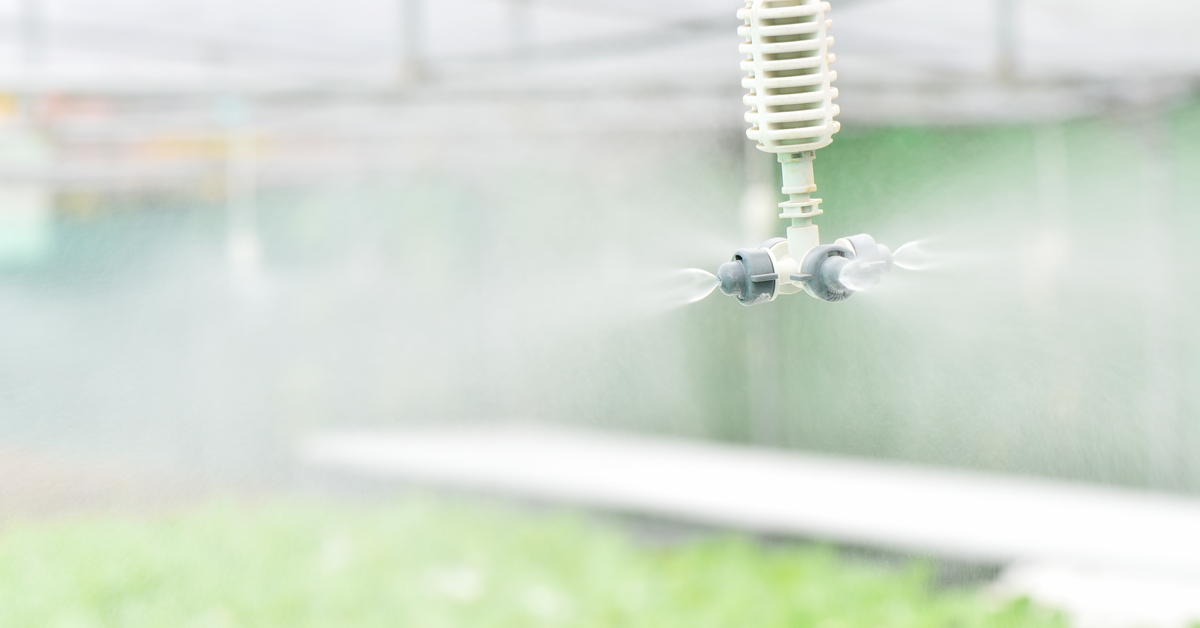
Congratulations – you’ve successfully grown your own crops in your greenhouse. To maintain the success and overall health of your plants, it’s important to manage the humidity and temperature levels within the greenhouse.
Why is it important to manage the humidity and temperature in your greenhouse?
For plants to remain happy and healthy it is important to nurture a suitable living environment. Having high levels of humidity or setting the temperature too high or low causes the environment to be too wet, resulting with stressed plants. Stressed plants are more prone to pests, mold and mildew. It is important to remember that an environment where temperature and humidity are controlled will encourage plant performance and increase the transpiration rate for nutrient uptake, leading to tastier produce, rapid production of crops and the ability to steer plants to a growth cycle.
What are the challenges of managing temperature and humidity?
Maintaining consistency
-
It can be tricky to maintain a consistent temperature and humidity level inside a greenhouse. It’s important to ensure that temperature is distributed equally through the greenhouse to avoid creating microclimates.
Transpiration
-
Managing temperature and humidity will allow you to control the transpiration rate to the plants. By keeping the humidity at an optimal level, you can increase evaporation of moisture in leaves.
Condensation
-
Condensation will form on plants, fruits and walls if humidity levels are not controlled. Areas of condensation will create a breeding ground for diseases and mildew with harmful effects to your crops.
Outside influences
-
It is important to be aware of what is happening outside and inside of your growing environment to balance the outdoor and indoor air to create a stable environment for your crops.
Are temperature and humidity exclusive?
No, they are not exclusive. It is important to remember that every time you adjust the temperature, it will affect the humidity and vice versa. You’ll want to do some experimentation to find the correct levels for your plants.
Is there a one size fits all solution?
No, there is no one size fits all solution. Due to different climates around the world, growers will have to use methods that best suit their environment. For example, a grower in the Bahamas will have heat and humidity issues, whereas someone growing crops in Colorado will have issues concerning a cold and dry environment.
Economic issues should also be highlighted. Some areas might get subsidies on electricity or gas supplies, which will dramatically affect the way you choose to control your environment.
What are some methods to control temperature and humidity?
There are a variety of methods you can use to control the greenhouse environment, including fans, vents, wet walls, shade cloths, radiant heating and fogging.
Fans
Two types of fans can be used to ensure your greenhouse has consistent air movement. Firstly, a Horizontal Airflow (HAF) fan can be mounted on the roof and the sides of the greenhouse. Not only is HAF cost-effective, but it will eliminate microclimates and help keep your crops growing at the same pace. The second option is an extraction fan. Extraction fans cool down the greenhouse by drawing air from the outside and exchanging it with air from within the greenhouse. Using an extraction fan will help keep the greenhouse cool inside and can reduce humidity.
Vents
When discussing vents, the first thing to remember is no matter what automation solution you choose, ensure that you have a weather station. A weather station enables you to monitor temperature, outside humidity, solar levels, rain levels and wind. There are two commonly used types of vents. Roof vents are a passive cooling method using natural convection of hot air. Side vent walls can be used to protect plants while increasing airflow within the greenhouse.
Wet Walls
Wet walls are an active cooling method to lower the temperature of the greenhouse. This method uses a gutter at the top from which water trickles through the wet wall down into a collection pipe. The water then goes through a filtration system and is recirculated. A combination of a wet wall and extraction fan is a cost-effective method of cooling down greenhouses by 10 – 15 degrees. While using wet walls, it is important to monitor humidity levels and cut off the water supply to the wet wall if the humidity is getting too high.
Shade Cloths
Shade cloths are curtains that roll out over rails located above your crops. Using solar energy will help save money but you need to ensure you control the exposure level of solar energy to plants and utilize shade screens to protect tips of leafy greens from burning. Another important factor to consider is transmission level. When selecting an shade cloth, choosing some tighter or looser weaves will significantly impact the climate. A looser weave addresses excessive humidity whereas a tighter weave traps the humidity and temperature. Radiant cooling can be used to prevent a drop-in temperature overnight and reduce stress in plants in colder climates.
Radiant Heating
Radiant heating is an effective method of heating your greenhouse, especially for vine crops. Radiant heating starts with a boiler which is controlled by valves that allow hot water to travel through metal pipes, heating up plants and emitting heat into the greenhouse. Controlling the temperature water in the pipes will allow you to increase pipe temperature and affect the ambient heat of the air around the plants.
Fogging
Baby plants, micro plants and vegetative plants prefer more humid environments. Depending on your location and environment, you may consider adding a humidity system. A cost-effective way to achieve this in a controlled environment involves a misting system that sprays mist over the entire crop. A potential problem with this system is that large droplets of water may fall on your plants, damaging crops. Another option is a high-pressure fogging system which creates micro-droplets which increase humidity without damaging crops. A combination of energy curtains and a fogging system will hold humidity within greenhouses.
Finding the right balance of humidity and temperature in your growing environment is crucial to the health and success of your crops. If you’re ready to start exploring options that fit your greenhouse needs, contact Bluelab today.



.png?height=100&name=Meet%20the%20team%20%20(4).png)

Submit a comment